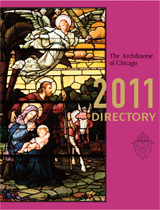Fertility is ‘a reality to live’ not a ‘problem to solve’

A regular feature of The Catholic New World, The InterVIEW is an in-depth conversation with a person whose words, actions or ideas affect today's Catholic. It may be affirming of faith or confrontational. But it will always be stimulating.
Teaching couples how to watch the natural occurring signs in a woman’s body for fertility and how to use that to plan or avoid pregnancy is not work for the faint of heart.
For Maria Garcia of the Office for Family Ministries for the Archdiocese of Chicago, it is a mission. Garcia has taught natural family planning, or NFP, to couples all over Chicago for many years and serves on international committees to teach the Billings Ovulation Method of NFP to Spanish speakers.
Garcia recently spoke with editor Joyce Duriga.
Catholic New World: There is a misconception out there that natural family planning, or NFP, is the same as the rhythm method made popular years ago. What is the difference between the two?
Maria Garcia: We have been trying to educate people on this issue for the longest time, and I think little by little we are getting through so people understand that the modern NFP methods are not what we used to know as “rhythm.”
The rhythm or calendar method was one of the earliest NFP methods used more than 50 years ago. It was based on the theory that the time of ovulation could be determined by calculating from previous menstrual cycles, and not on any particular signs or observations. It often proved inaccurate because of the unique nature of each woman’s ovulation cycle. Some women have very irregular cycles and almost all women have a cycle of unusual length once in a while, caused by stress, age, or other factors.
Modern NFP methods are progressive. They are based on day-to- day observations of the naturally occurring signs and symptoms of the fertile and infertile phases of the menstrual cycle, and on over 30 years of scientific research on human fertility. NFP methods observe the changes associated with ovulation, treating each cycle as unique.
CNW: Several methods of natural family planning exist.
Garcia: Yes, there are several NFP methods available today. The most common ones are the Billings Ovulation, Sympto-Thermal and Creighton Model methods, all with an effectiveness rate of 97 percent to 99 percent for postponing pregnancy. Basically most of the methods rely on the mucus released from the woman’s cervix as the most reliable sign of fertility. This external observation may be sensation, look or touch or a combination.
Through daily observation the woman learns to be aware of the presence or absence of the cervical mucus, and can learn to recognize her fertility and infertility. For some methods, besides the cervical mucus, other body signs such as temperature or changes in the shape or texture of the cervix are also observed.
CNW: Why does the Catholic Church support natural family planning as a way to regulate births instead of birth control or contraception?
Garcia: Artificial methods prevent conception or pregnancy through the use of devices, chemicals or drugs that change or interfere with the normal reproductive process. With some artificial methods conception takes place, but the resulting pregnancy is terminated because the human embryo is unable to survive in the disturbed uterus as a result of the device or drug.
NFP, on the other hand, can be used to achieve, postpone or avoid a pregnancy. To avoid, you refrain from intercourse at the time of fertility; to achieve, you plan intercourse at the time of fertility. NFP is not a contraceptive so it does nothing to work against conception. It is unique among the methods of NFP because it enables its users to work with the body rather than against it. Fertility is viewed as a reality to live, not a problem to be solved.
CNW: You offer NFP classes in English, Spanish and Polish. You mentioned that you’ve seen an increase in interest from English speaking couples recently. Where is that coming from? How do the different groups receive NFP?
Garcia: I know that the increase in couples attending the NFP English classes is a result of the archdiocesan marriage guidelines that came out in 2005. The guidelines contain “How to get Married in the Archdiocese of Chicago,” which gives the couples 10 steps for good marriage preparation, and NFP is listed as one of the steps.
I believe that many priests require that couples go through all 10 steps in order to get married, but the interesting thing is that the majority of the engaged couples that choose to attend an NFP class come not because it is required, but because they choose to. They recognize that all 10 steps are important tools that will help them build a strong marriage.
Through NFP not only are they adhering to the Catholic teachings on the use of contraception, but they are also linking healthy fertility with their sexual expression.
Why there has not been the same response in interest in the Polish and Hispanic community, it would be good to know, but I imagine it could be a combination of many factors: culture, education, immigration status. Information about what NFP is and what it is not, and the availability of classes in their own language might not be as easily available to these groups as it is for Englishspeaking individuals.
CNW: Promoters say that using NFP can strengthen marriages.
Garcia: NFP reflects the dignity of the human person within the context of marriage and family life, promotes openness to life, and recognizes the value of every child. By respecting the love-giving and life-giving nature of marriage, NFP enriches the bond between husband and wife.
NFP causes no harmful side effects to husband, wife or unborn child.




